In this topic, we will review what fitness is and how the body adapts to exercise, including the general adaptation syndrome (GAS). We'll take an in-depth look at FIIT - a method for general guidelines on what to include in a fitness plan.
Then we will get into training principles. Great personal trainers have a solid understanding of training principles and how to apply them to programming.
Understanding training principles allows you to monitor the exercise load or stress placed on a client. This is essential for creating safe and effective programmes that help clients achieve goals safely.
You will learn about:
- Specificity
- Overload
- Adaptation
- Individualisation
- Reversibility
- Rest and recovery
- Maintenance
- Ceiling (flatlining)
- Variety
- Interference
Before we get into specificity (and the other training principles) we need to have a good understanding of what is meant by fitness training overall.
What is fitness?
Fitness is the ability to make enough energy to meet demands placed on the body. A good PT knows the components of fitness and how training programmes affect them.
Fitness training replicates the movements and energy systems involved in a sport or physical activity. It is meticulous, and grounded in science but still allows a large degree of creativity.
How the body adapts to exercise
Let's think about how the body adapts to exercise. This graph illustrates the general adaptation syndrome (GAS) and recovery to super-compensation (shown by the red curve). An explanation follows.
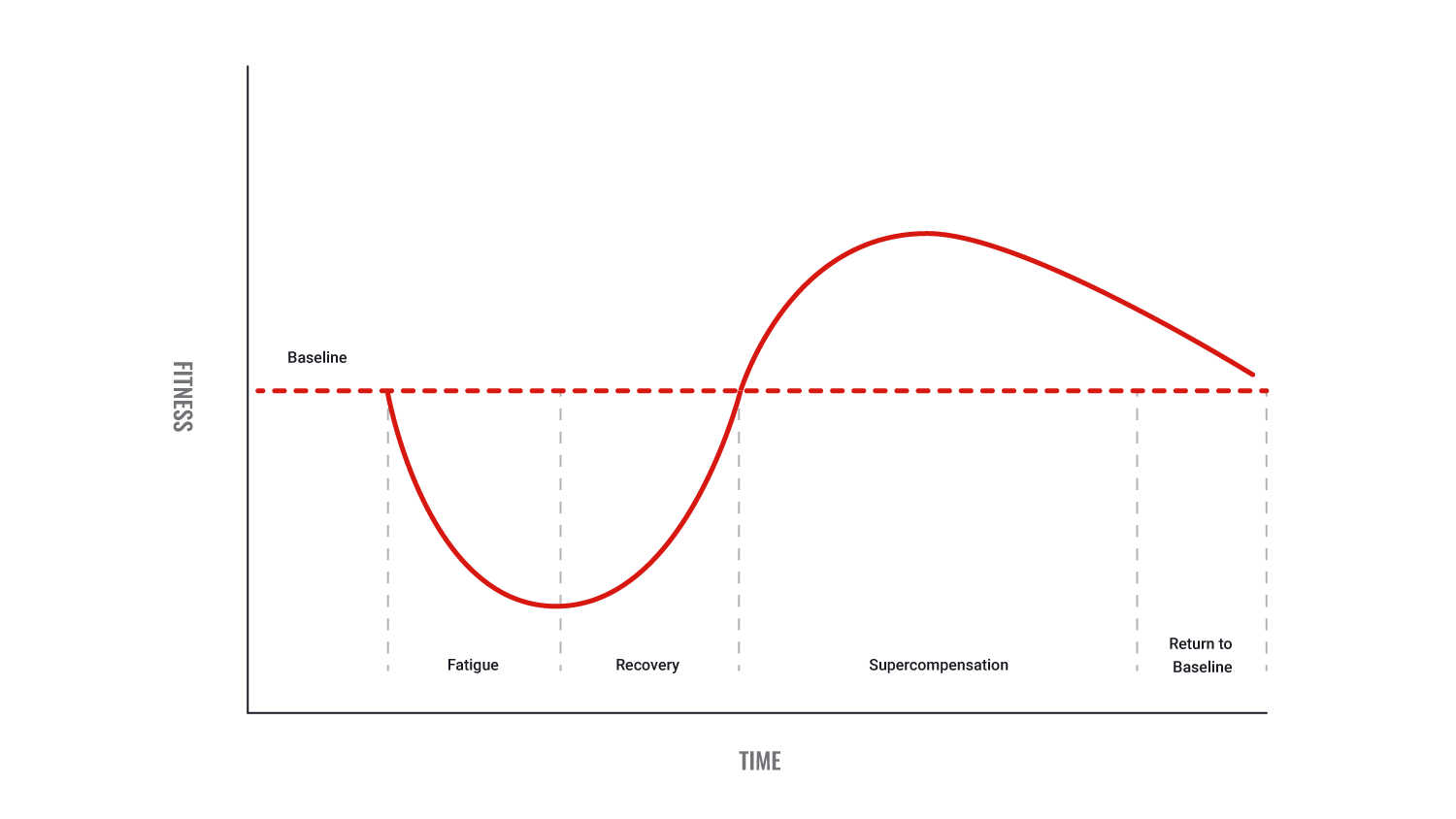
What does this graph tell us?
- The general adaptation syndrome (GAS) illustrates how the body adapts to stress. For our bodies, exercise is seen as acute stress that needs to be 'survived' or overcome.
- For example, the horizontal red line represents your current equilibrium or baseline level of fitness. When exercising, you will notice the line drops down into the negative (fatigue).
- After the session is over your body tries to overcome and recover from the stress of exercise over hours or days. You will see the curve extend above the original baseline (super-compensation) into the positive. This represents improved fitness.
- If you add another exercise stress you repeat the process with a larger super-compensation. When you do repeated workouts your fitness will improve systematically. This is especially so if you train while in the super compensation period (within reason).
The key to training success is gauging the appropriate time to add the next workout, i.e. when it is above, not still below the baseline. Continuing competing workouts before full recovery has occurred will cause poor training adaption, burnout, fatigue, and possibly 'de-training' where you undo some of the good work you have achieved so far. So timing and rest are hugely important.
Fitness and recovery time
The following graph shows fitness against recovery time for various forms of training.

What does this graph tell us?
The graph shows approximate recovery times for different types of workouts in hours. You will see you recover very quickly from extensive aerobic work (long slow distance) and slowly from very intense anaerobic work. Note the following:
- Extensive aerobic work targets regeneration
- Intensive aerobic work targets aerobic capacity
- Extensive anaerobic work targets anaerobic capacity
- Intensive anaerobic work targets aerobic and anaerobic power.
- Aerobic and anaerobic power
The following table provides additional information that explains the incremental improvements to each type of workout.
| Training types | From | To |
|---|---|---|
| Extensive endurance | 8 | 12 |
| Intensive endurance | 24 | 30 |
| Sprints/short sets | 30 | 40 |
| Extensive anaerobic training | 36 | 48 |
| Extensive strength training | 40 | 60 |
| Intensive anaerobic training | 40 | 60 |
| Intensive strength training/competition | 48 | 72 |
An acute training variable is a part of the exercise session that can be manipulated ‘acutely’ or as part of every individual training session. To progress or overload a client, you must consistently manipulate some acute training variables to place additional stress or recovery on the body. The most important acute training variables are the FITT principles.
You need to think about these 4 principles when you create workouts to fit your goals and fitness level or those of your clients.
- Frequency = how often you exercise
- Intensity = how hard you exercise
- Time = how long you exercise
- Type = what kind of exercise you do
Frequency

The frequency of training refers to the number of exercises within a time period (usually one week).
The American College of Sports Medicine (ACSM) recommends 3 to 5 sessions a week is enough to induce beneficial cardiovascular and muscular adaptations.
Training may be as frequent as 6 to 7 times per week depending on the training age of the athlete. The law of ‘diminishing returns’ however, states that there comes a point where increased training does not result in significant training adaptations. It is always better to start with 3 exercise sessions and build up gradually.
One of the keys to training success is gauging when to conduct the next workout. Continuing to perform workouts before full recovery can cause poor training adaption, burnout, fatigue, and possibly 'de-training' where you undo some of the good work you have achieved so far. Timing and rest are hugely important.
Several factors can determine how many times per week someone should train, these include:
- Type of exercises used
- Number of muscle groups trained per session
- Structure of the program (volume and intensity)
- Clients training status and overall fitness
- Clients work schedule, social, and family commitments
- How mentally prepared or motivated a client is to undertake a training programme
Look at a person's schedule holistically. If a particular day is more important than others (e.g. they play in a competition on Saturday), then placing the most intense sessions earlier in the week may be beneficial to avoid having an impact on performance in the game. Consideration should be given to ensure adequate rest (recovery).
The frequency of sessions should also be somewhat determined by your recent exercise history and training age. Someone completely new to exercise should not have the same number of training schedules as a professional athlete!
Training status
The following is a rough guide to the different training statuses of clients. These can vary slightly from individual to individual. Frequency will depend on the resistance training status of the individual.
| Beginner | Someone who has not consistently trained regularly and/or achieved results for six months or more. Someone new to an exercise type, e.g., a bodybuilder wishing to focus on their cardio (chances are this is a new training focus for them). |
|---|---|
| Intermediate | Has been training consistently and regularly for six months or more. They have built up basic strength, skills in their programme, and almost mastered their technique. |
| Advanced | Classified not on time, but rather on their skill and technique development. This usually takes years. Typically, advanced clients will have already mastered the techniques. They understand the rationale behind their programme and technique and are very close to, if not already, achieving their maximum natural potential. This category typically sees the least amount of people. |
Training guidelines
| Training status | Resistance training sessions per week | Aerobic training sessions per week |
|---|---|---|
| Beginner | 2-3 per week | 2 days ON, 5 days OFF, 3 days ON, 4 days off |
| Intermediate | 3 if using full body, 4 if using a split routine | 4 days ON, 3 days OFF, 5 days ON, 2 days OFF |
| Advanced | 4-6 days per week | 6 days ON, 1 day OFF |
The following graph shows the inverse relationship of intensity to volume and frequency.
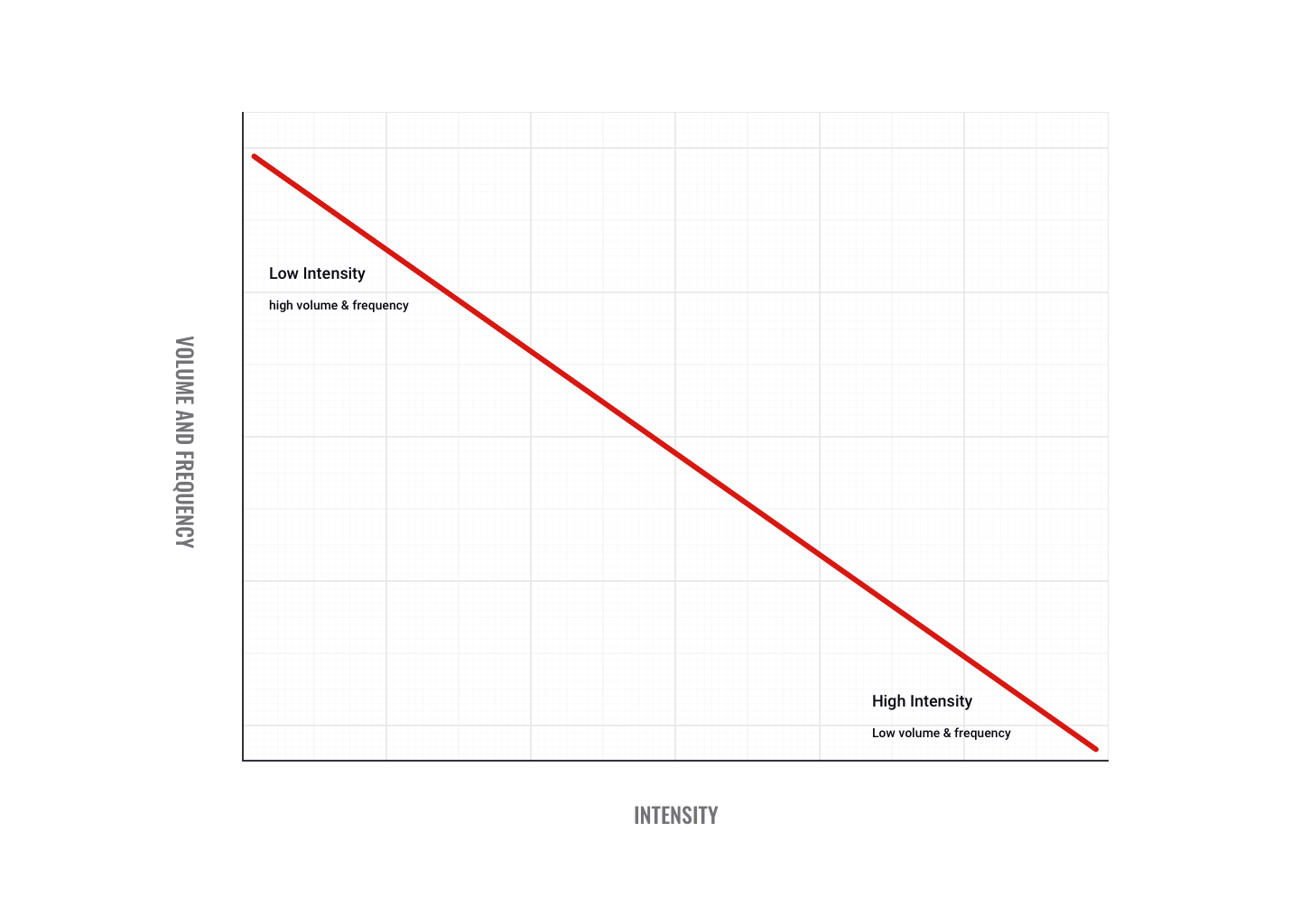
The graph illustrates:
- Low-intensity exercise (such as walking) equals more volume and frequency at a lower intensity.
- High-intensity exercise (such as running or using a stairclimbing machine) equals more intensity, lower volume, and frequency.
Intensity
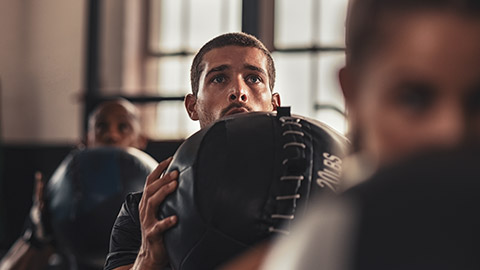
Exercise intensity is how hard you push yourself. It can relate to the speed of efforts, weight lifted, time to complete a task, or how much rest you gave yourself.
Intensity is an important aspect of FITT, but probably the hardest to monitor. The best way to gauge the intensity of exercise is to monitor heart rate. This works best for cardio and circuit-type classes. Trainers will monitor and set workout intensity through HR training zones (i.e. a % of HR Max).
| Zones | MHR (max heart rate) range | HRR (heart rate reserve) range | Description |
|---|---|---|---|
| Zone 1 - Recovery | 65-75% | 60-70% | This zone is good for general aerobic conditioning and improving endurance. It's sometimes called the "fat burning" zone since you will burn fat most efficiently when running within this range of intensities. Short runs within this zone are perfect for recovery, and it's also ideal for longer runs, warm-ups, and cool-downs. |
| Zone 2 - Aerobic | 75-85% | 70-80% | This zone is where the majority of the distance runner's training should take place. Training within this zone will improve and strengthen the cardiovascular and peripheral systems, promote increased vascularisation (meaning a greater blood and oxygen supply to muscles), and build resistance to injury. |
| Zone 3 - Anaerobic | 85-95% | 80-90% | This zone covers intensities from just below to just above your anaerobic threshold (the middle of this zone is roughly the intensity you could maintain for an hour in a race situation). Training in this zone can help raise your anaerobic threshold meaning you can run harder and faster at both this and other intensities. |
| Zone 4 - Redline | 95-100% | 90-100% | This is the zone that is used for interval training. This zone will help train your fast twitch muscle fibres and raise your VO2 max. This type of training should be limited. |
Online calculators for HR training zones can help you quickly calculate training zones: Heart rate zones calculator by Runbundle.
Intensity during resistance training is set via the amount of weight lifted (usually as a % of 1RM). This weight will dictate how many reps can be done.
Intensity can be measured in several ways. We will look at 7 methods:
- Method 1: Age-predicted max heart rate percentage (APMHR)
- Method 2: Heart rate reserve
- Method 3: VO2max (oxygen consumption)
- Method 4: Metabolic equivalent (METs)
- Method 5: Ratings of perceived exertion (RPE)
- Method 6: Repetition maximum (%1RM)
- Method 7: Percent of maximal effort
Read the description and calculation for each method carefully as this is important information.
Method 1: Age-predicted max heart rate percentage (APMHR)
Heart rate (HR) is the most commonly used measure of intensity for cardiovascular exercise. It is easy to calculate and gives a fairly accurate measure of how hard the cardiovascular system is working. HR is not an accurate indicator of anaerobic intensity.
Your HRmax can be calculated using the following estimation:
HRmax = 220 - age
This calculation is most commonly used when working with obese clients. The following adjustment HRmax = 200 – (0.5 x age) works well for older individuals.
Remember, an individual’s actual HRmax may vary by ±10 bpm from this estimation. There are different calculations for different athlete types and as science and technology improve, our knowledge of fitness calculations evolves. Your gym may require you to apply a specific calculation.
Method 2: Heart rate reserve (HRR)
Heart rate reserve (or the Karvonen method) describes the difference between someone’s HRmax and HRrest, i.e. the predicted maximum heart rate and measured heart rate. It has been shown to more accurately reflect the percentage of VO2max that the client is working at than the HRmax method alone. A key component of an effective training programme is making sure your client is training in the correct training zone. This will increase their ability to achieve their training goals.
This method also considers the changes in an individual’s resting HR as they get fitter.
Heart rate reserve (HRR) can be calculated using the following formula:
HRreserve = HRmax - HRrest
Calculating resting HR is best done first thing in the morning when you wake up and before you eat and get moving for the day. Many fitness trackers will monitor your resting heart rate through the night.
Worked example
Let's take this further and calculate a client’s training zone. Let's say you want the client to work at 75% intensity. First, you need to calculate what 75% for this client is. This is the target heart rate that they need to achieve to reach the desired training zone. This is where we use the Karvonen formula which is often used to design a training programme. It is important that you are comfortable with this formula:
Target HR Training Zone = HRrest + (% Intensity x (HRmax - HRrest))
Note, the last part of this equation is simply the HRreserve but written out in full, i.e. HRmax - HRrest.
To use this formula, you need to know the client's age, resting HR, and the desired training zone (% Intensity). With the HRrest and age, we can calculate HRmax. From there, we will have all the values we need to complete the calculation.
Let's practice by calculating the target heart rate required for a particular training zone for our client who is 62 years of age and has an HRrest of 58 bpm. In this example, our client needs to work at an intensity of 75% of their Heart Rate Reserve. First, let's calculate the HRmax.
- HRmax = 220 - age
Therefore, HRmax = 220 - 62 = 158 bpm.
Now we know:
- HRrest = 58 bpm
- Age = 62
- Intensity = 75% or 0.75
- HRmax = 158 bpm
We now have enough information to use the Karvonen formula. You'll need to use either a scientific calculator (you can change the settings on your phone or computer's calculator) or follow the order of operations i.e., BEDMAS. If you use a scientific calculator, you can enter the formula in one step (including brackets) to get the answer. We have shown the full working using BEDMAS.
- Target HR= HRrest + (% Intensity x (HRmax - HRrest))
- Target HR= 58 + (0.75 x (158 - 58))
- Target HR= 58 + (0.75 x 100)
- Target HR=58 + 75
- Target HR= 133
Bingo! We now know that for this client to work at 75% of their HRR (heart rate reserve) they are required to achieve a heart rate of 133 bpm.
Method 3: VO2max (oxygen consumption)
VO2 max is the maximum amount of oxygen your body can take in and use during physical activity. It is the size or power of your aerobic system to deliver oxygen to your muscles. The test and calculation are commonly performed in a laboratory environment to determine the aerobic endurance of an athlete at the beginning and during training.
VO2max is calculated by measuring the exchange of gas entering and leaving the lungs, i.e., the amount of oxygen going into the body minus the amount coming out. The VO2max test begins at a light-intensity exercise on a treadmill or bike and gets slightly harder each minute until maximum exertion is reached.
Watch this video from the University of South Australia which demonstrates VO2 max testing of a client in the gym.
Method 4: Metabolic equivalent (METs)
A MET or 'metabolic equivalent' is one way to measure exercise intensity. A MET is typically a calculation of your metabolic rate at work relative to your resting metabolic rate. Sports scientists measure activity in metabolic equivalents or METs. One MET is defined as the energy it takes to sit quietly. METS can be classified as:
- Light (<3.0 METS) such as walking, fishing, light housework
- Moderate (3.0-6.0 METS) such as brisk walking, mowing the lawn, light cycling
- Vigorous (>6.0 METS) such as jogging, hiking, soccer
One MET represents the resting oxygen consumption, which is equivalent to 3.5 mL/kg/min.
Resting oxygen consumption can increase up to 20 times during maximal exercise in a trained individual (that is, VO2 max equal to 70 mL/kg/min). A 5-MET workload is equivalent to exercising at 5 times your resting oxygen consumption and would equal 17.5 mL/kg/min or easy exercise for most people.
The following graphic compares the METs for home activities against sports and leisure activities:

The following video features the Move your MET app which some of your clients may find useful.
Method 5: Ratings of perceived exertion (RPE)
Ratings of Perceived Exertion (RPE) is a subjective estimate made by the client of their current workload intensity. It is also known as the 'talk test'. It is an indicator to monitor and guide exercise intensity, typically from the client's perspective and can be modified to use with clients including special populations such as the elderly.
The client is asked to rate their level of physical exertion on a scale of 1-10 (or 6-20 on the original scale), with 1 being no perceived exertion and 10 being maximal exercise. It is a subjective measure, but research has demonstrated that when asked, people do accurately score their level of exercise exertion.
As a trainer, you will use your observation skills when using this test. Take notice of the client's appearance and demeanour. E.g., you have a young male client who has scored himself at a 3. Yet, he is struggling to talk in sentences and is sweating heavily on his face. In this instance, you should use your judgment about the client's rating.
The following table describes what a scale might look like in a gym.
| RPE Scale | Rate of Perceived Exertion |
|---|---|
| 10 - Max effort activity | It feels almost impossible to keep going. Completely out of breath, and unable to talk. Cannot maintain for more than a very short time. |
| 9 - Very hard activity | Very difficult to maintain exercise intensity. Can barely breathe and speak only a few words. |
| 7-8 - Vigorous activity | Borderline uncomfortable. Short of breath, can speak a sentence. |
| 4-6 - Moderate activity | Breathing heavily, can hold a short conversation. Still somewhat comfortable, but becoming noticeably more challenging. |
| 2-3 - Light activity | Feels like you can maintain it for hours. Easy to breathe and carry on a conversation. |
| 1 - Light activity | Hardy any exertion, but more than sleeping, watching TV and so on. |
The following table provides an example of RPE used in resistance training.
| RPE Scale | Rate of Perceived Exertion |
|---|---|
| 10 - Max effort activity | Could not do more reps or load. |
| 9.5 | Could not do more reps, could do slightly more load. |
| 9 - Very hard activity | Could do one more repetition. |
| 8.5 | Could definitely do one more repetition, maybe two. |
| 8 - Vigorous activity | Could do two more repetitions. |
| 7.5 | Could definitely do two more repetitions, maybe three. |
| 7 | Could do three more repetitions. |
| 5-6 - Moderate activity | Could do four to six more repetitions. |
| 1-4 - Light activity | Very light to light effort. |
Method 6: Repetition maximum (%1RM)
When resistance training, the easiest way to quantify intensity is to use a percentage of your one-repetition max (%1RM). The %1RM that you use in a workout plan will depend on your training goals which generally include:
- Muscular endurance (how many times can you lift)
- Mass or bodybuilding (hypertrophy)
- Strength (how much can you lift)
- Power (how quickly can you lift)
The 1RM can be determined with a maximal or multiple RM test.
The % value you use depends upon the goals of the session. If the goal is muscular strength, a high %1RM will be used. If the goal is muscular endurance then completing more reps would be the focus.
E.g., you test a client’s strength (1RM) on a bench press and they lifted a maximum load of 80kg. Your exercise prescription for improving muscular endurance requires them to lift a load of 65% 1RM for 15 reps.
- 80kg x 0.65 = 52kg for 15 reps
Method 7: Percent of maximal effort
In some workout types, using HR or other methods may not work effectively, such as in training the glycolytic energy system for a series of longer sprint efforts. Remember, you cannot use HR to measure intensity for anaerobic sessions.
In this example, let's say you want to develop your short sprint speed. To get optimal speed adaptations, you need to train at least higher than 90% of max effort for that sprint.
Let’s assume the workout is 10 x 20 m sprints at 92% of max effort. In your previous fitness testing, you did a maximal 20m speed test and recorded a time of 3.10s.
- Training speed = max effort x training %
- Training speed = 3.10 seconds x 0.92 = 2.85 seconds
The workout would be: 10 x 20 m sprints @ 2.85 seconds with 2 minutes recovery.
Let’s calculate the same for bike sprints to train the glycolytic system. The workout asks for 6 x 30-second efforts at 85% of max. In your previous fitness testing, you did a maximal 30-second effort on the bike and averaged 700 watts.
- Training intensity = max effort x training %
- Training intensity = 700 watts x 0.85 = 595 watts
The workout would be 6 x 30-second sprints @ 595 watts with 90 seconds recovery.
Time

How long does each session last (duration), how many sessions a week, and what time of day you exercise.
The duration of an exercise session will differ greatly depending on the intensity and type of training. At a minimum, it is recommended that people perform at least 20-30 minutes of moderate exercise at least 3-4 times per week. This number increases as fitness improves.
Time doing other exercise types, such as resistance training, will depend on the structure of the workout, how much rest you take, and the intensity of the session. Remember the inverse law of duration and intensity, as one goes up the other must come down! The art of training is blending a good mix of intensity and volume/duration. This is called periodisation.
The time chosen for a workout will be completely dependent on:
- Type and intensity of exercise
- Time available for training
- Current fitness level
Type
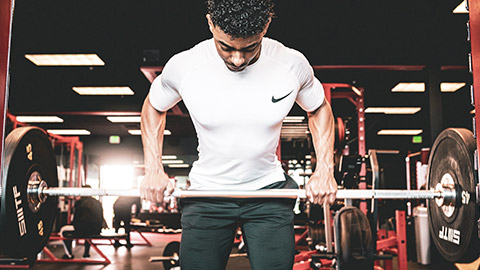
The type of exercises you do - the activities.
The type of exercise programmed should directly relate to the exercise goal(s). This is known as specificity. Ensure training goals are appropriate and aligned, rather than working against each other. E.g., someone working on aerobic fitness and speed in the same training block. Essentially, choose the exercise modes that will best transfer to the performance goals you and your client have set.
A programme could include the following types:
- Flexibility/stretching exercises
- Yoga/pilates
- Anaerobic exercises
- Sprinting exercises
- Weight training
- Circuit training/cross training
- Aerobic exercises
- HIIT training (high-intensity interval training)
- Boxing or combat training
- Running, swimming and cycling
The type of exercises you choose for a client will depend on:
- Biological age, training age, and experience
- Interests and what the client enjoys doing
- Exercise goals
- Training specificity for a sport or activity
- Previous or current injuries
- Current conditioning levels
- Weight
- Special conditions
Choosing exercise modes: Cardio
If your goal is general fitness (no particular performance goal): Choose any mode of cardio training you like! E.g., you could mix things up from session to session, bike, rower, run, swim, and so on.
If you play a sport: Try to align your training modes with the sport. I.e. if you play a field sport, choose running as your primary cardio mode as it will transfer better to your sport. If you are a cyclist, cycle. You can make this more specific by training on surfaces that relate closely to your sport, e.g., courts, grass, track, and water.
Choosing exercise modes: Resistance
If your goal is general fitness (no particular performance goal): Use a variety of approaches to regularly change the stimulus, e.g., strength, endurance, hypertrophy, tempo, compound and isolation. You can even mix up training approaches within the same session.
If you play a sport: Tailor your exercise selection to target key muscles involved in successful performance in the sport. E.g., middle-distance runners wouldn’t need a lot of shoulder exercises. The time of year will also impact your approach (but we will cover this more when we get to periodisation).
Choosing exercise modes: Flexibility
If general flexibility maintenance is desired: A full body stretching approach done regularly should suffice, e.g., a general yoga class.
If an increase in specific flexibility is desired: A targeted, multi-dimensional approach should be used e.g., different stretching approaches, foam rolling, massage.
Volume
The overriding concept that has to be understood to apply the FITT principles effectively is training volume. To improve performance and fitness a person's training programme needs to increase in volume over time.
Volume is a combination of:
- The number of sessions
- The duration of sessions
- The intensity of sessions (% of HR, %1RM lifted)
Essentially, it considers the total amount of work done – e.g., km travelled, total weight lifted, number of reps etc.
Volume considerations:
- Total training volume should be lower for less trained individuals
- Total training volume will differ for different training goals – e.g., a rugby player vs an iron man athlete
Exercise should be specific to your client’s goals, needs, and capabilities.
Specificity refers to the changes the body makes in response to sports training. This change in the body or physical fitness is specific to the type of training completed. Very simply, what you do is what you get. This principle of specificity tells us that the adaptation to the body or physical fitness will reflect the type of training.
The results of a training programme are very specific to the task you do in that training programme. If you do strength training, evidence of your adaptation will be your ability to lift more and you will not observe cardiovascular adaptations. If the goal is to increase flexibility, the specificity principle would dictate that exercises should target flexibility should be a huge component of the programme, and there would be little point in including weight training.
Specificity forms an integral part of the advice you give and every programme you design. If there is no purpose to what your clients do, they will not meet their fitness and training goals.
Imagine you are working with a volleyball player who wants to increase her vertical jump. With the aspect of specificity in mind, you should consider factors such as the key muscle group(s) required to perform a vertical jump, assess what her current jump style and ability to perform this movement currently are (her baseline), and then establish what aspect of her current vertical jump ability needs to be trained to see an improvement.
Progressive overload is not a new concept. The 6th century BC saw a Greek athlete named Milo of Croton who competed in the ancient Greek Olympics and was well known for his incredible strength and wrestling prowess. Legend has it he achieved his strength by lifting and carrying a calf each day from its birth until it became a mature, full-sized ox. Milo is renowned for his success in wrestling, earning the title of 6-time champion at the ancient Olympic Games in Greece. What we can take from this is how Milo developed his strength, through progressive overload!
Exercise should overload the body in order for a positive adaptation to occur.
Progressive overload is when the workload you programme for a training session progressively increases as the client adapts to the training. You may start an athlete preparing for a marathon on a 5km run of medium intensity and move to a 10km run over time. Increasing the workload (or overload) is usually done to maintain the same training intensity after the adaptations have occurred. Typically, it is best practice to change only one variable at a time to accurately account for adaptations and observations made during training.
The following graph illustrates the progressive nature of the overload principle.
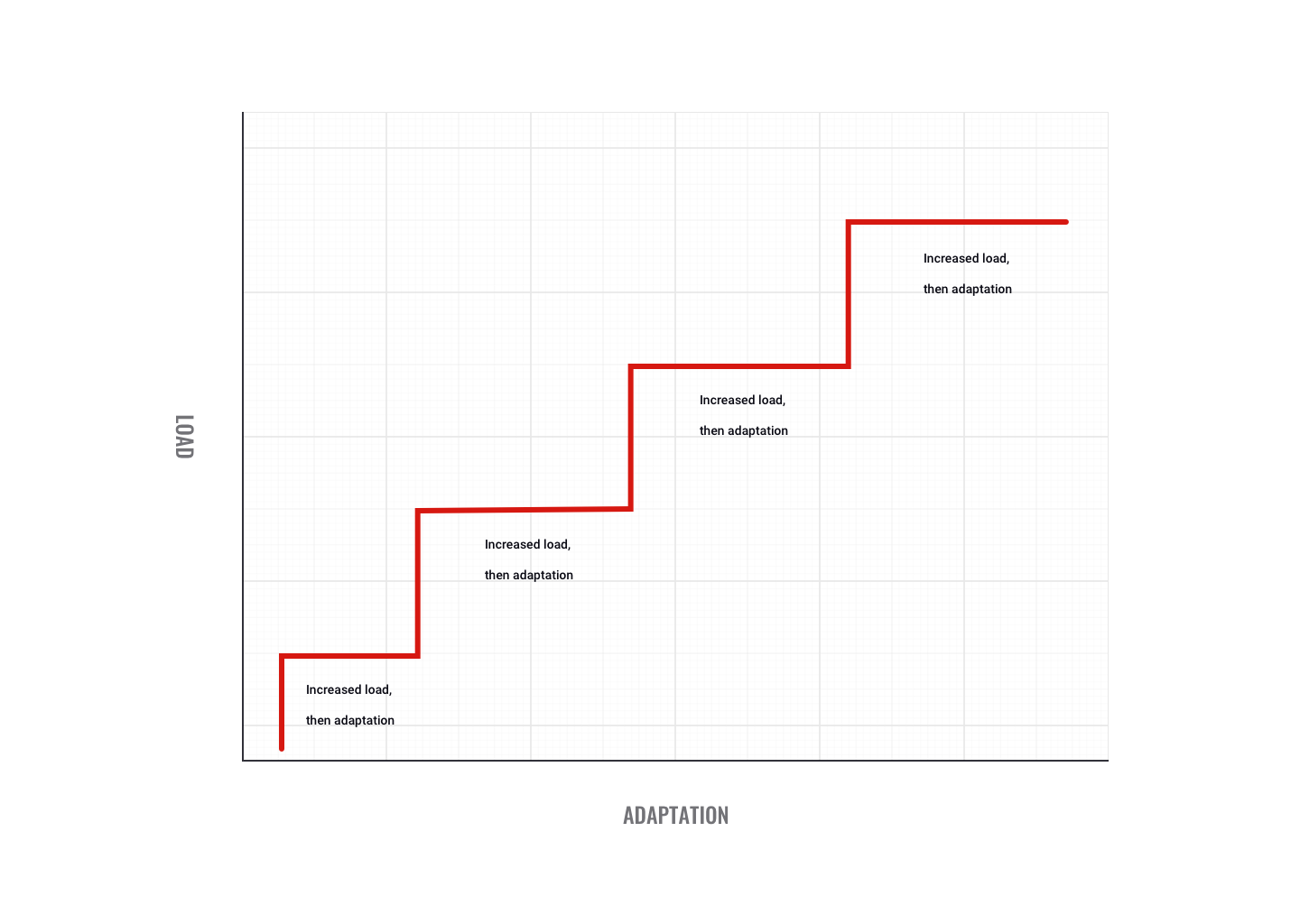
What does the graph tell us?
- Training must be a gradual and progressive process because too much overload can lead to injury and fatigue.
- You need to have a client exercise at a level above normal to create adaptations that cause the body to function more efficiently (overload).
- An appropriate overload for each person can be obtained by manipulating the frequency, intensity, and duration of exercise sessions. Gradually increase the training load and intensity from easy to difficult.
Any time we do anything more than sit around, we overload the muscles – so all types of training provide an overload on the muscles. However, if someone is already doing something, the way to overload their muscles is to either change what they are doing or increase the FITT principles. We can change the FIIT to make the body do more than before:
- F = Frequency of training
- I = Intensity of training
- T = Type of training
- T = Time of training (duration)
The training principle adaptation is linked to progressive overload. Adaptation refers to the process of the body adapting or becoming accustomed to a certain training technique or exercise through repeated exposure to the techniques or exercises. There are different phases of adaptation that the body will experience. These are shown in the following graph.
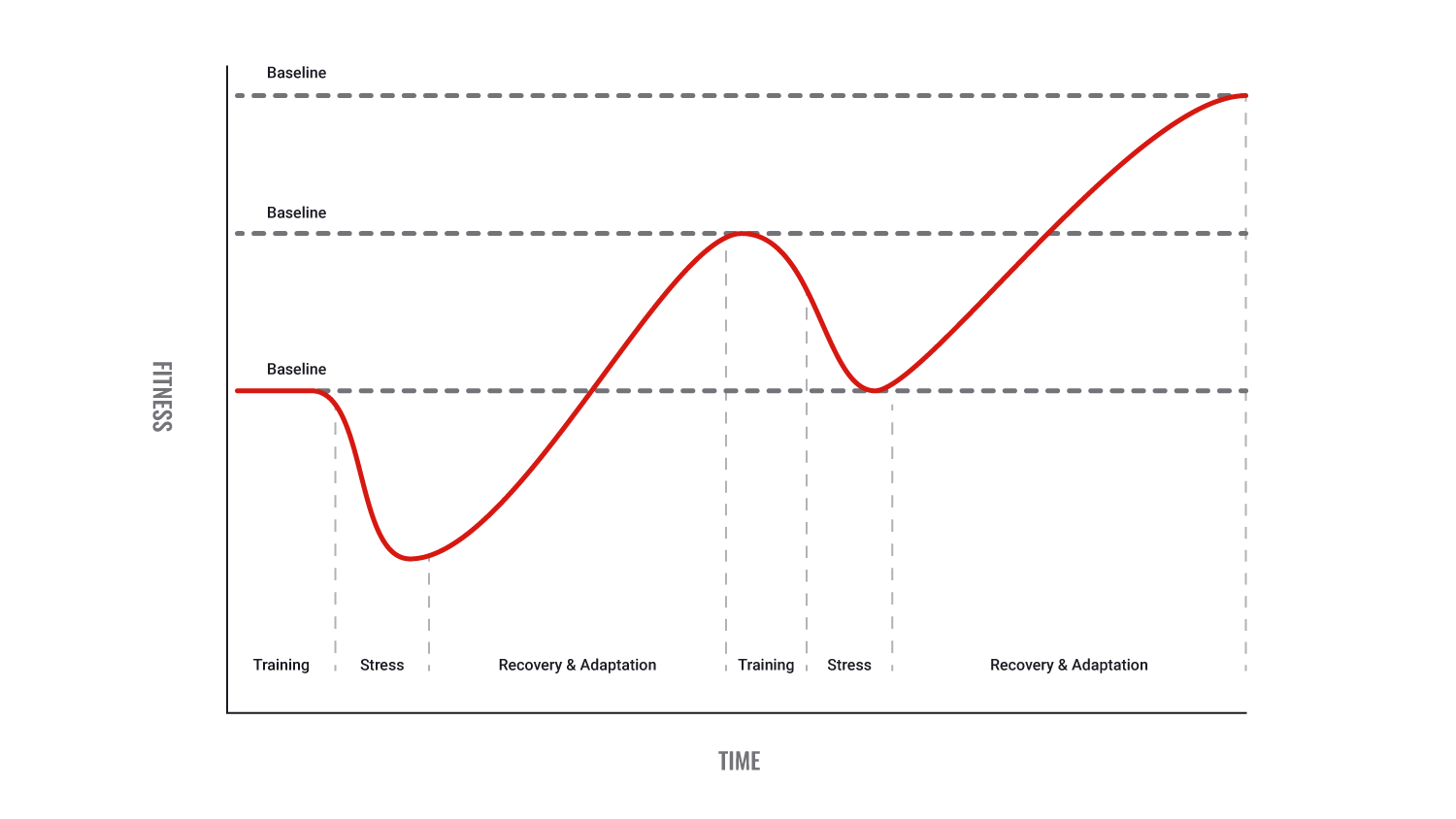
What does the graph tell us?
The body's response is an adaptation, which is your body's physiological response to training. When you do new exercises or load your body differently, your body reacts by increasing its ability to cope with that new load.
This graph shows the relationship between progressive overload and adaptation. This progressive overload is applied when the body has already 'mastered' what has already been asked of it and is ready to process a new stimulus.
Exercise should be specific to the individual completing the training. Individualisation focuses on the fact that training should be adjusted in relation to factors such as age, gender, stage of training, progress, injuries, health conditions, and previous skills development of the individual participating in the programme.
You are creating a programme specifically for your client, and you need to consider their needs and capabilities. This means it needs to be difficult enough for advanced clients and simple enough for beginners – think about what your client is actually capable of.
The goal of individualisation is essentially to work with a client's strengths whilst improving their weaknesses. Training programmes need to cater to the individual needs and preferences of each client. This may also mean changing your communication styles to cater for people in the general community who may not speak English as their first language and may not speak 'exercise'.
The following factors need to be considered when individualising a programme:
- Tolerance - clients have different tolerance levels
- Training needs - client's profile, including goals, strengths, and weaknesses

If you don't use it you lose it.
Reversibility states any fitness gains you make above your original baseline will gradually be lost once you stop adding appropriate training stimulus. Detraining can occur when:
- you stop training.
- your training is not regular enough.
Consider this scenario. Imagine you only train once per week on a Monday. By the time the next Monday rolls around, any gains have likely reverted back to or close to your original baseline. A minimum training regime of 3 times per week is recommended because the exercise stimulus is regular enough to prevent detraining between workouts.
As a general rule of thumb, you lose about 1% of your fitness gains per day after the first week of detraining.
Rest and recovery are required to allow the body time to adapt to exercise.
A good PT considers the client's total workload and how they can fit in rest and recovery time. Some clients have very heavy exercise demands and rest is crucial. This is something to consider when you are designing your plan for them. How many days a week will they do your workout plan? What about time for recovery sessions such as stretching?
Optimal adaptation requires recovery time. It is only during the recovery phase (days between workouts) that the body can change and adapt to the stress of the workout.
Recovery can be improved in various ways, such as through effective nutrition and hydration, light aerobic exercise, and stretching sessions. It is believed that 90%+ of an individual's time is spent recovering from exercise. If we get this wrong positive adaptations will not occur as quickly.
This is where you can write suggestions for how your client can recover well from their training programme.
The length of recovery needed may depend on the client's fitness level, training load (intensity, duration, type, and frequency), and nutritional factors such as diet, work, family commitments, sleep patterns, and so on.
There are 2 ways you can remember the rest and recovery principle.
REST model:
- Repair
- Eat
- Sleep
- Time
4 Rs of the Recovery model:
- Refuel
- Rehydrate
- Repair
- Relax

Maintenance is achieved following a progressive base of training and when a plateau has been reached. At this point, it is not the individual's goal to improve further, but to keep or maintain the level of fitness they now have. Once a plateau has been reached, the individual only has to do 30% of the training needed to get to this point to maintain their fitness.
Fitness can be maintained by altering the variables of the FITT principles. When considering which variable(s) to manipulate to preserve progress achieved to date; the intensity of the training must remain the same. The volume of training can be significantly reduced, but the intensity must remain the same to avoid regression.
Maintenance phases can also be useful when clients are juggling different training types. E.g., opposing training adaptations such as strength training and endurance training can interfere with each other if done at the same time. One way to overcome this is by alternating maintenance phases:
- Develop strength while dropping your endurance training by 50-60% for 3 weeks.
- Alternate to training endurance hard and maintain strength with a 50-60% drop in volume.
Imagine the following scenario. Reuben and his partner have been your clients for six months. They have a holiday coming up and Reuben admits they don't train much when they are on vacation. You discuss the options with Reuben and agree to work them hard leading up to the vacation, then put them on a maintenance program while they are away. This could drop training volume by up to 70% but maintain their current level of fitness so when they come back they are not back at square one. Alternatively, they may not like the idea of training on holiday, and may not be aware that this would lead to a difficult re-entry into their training when they return (reversibility).
Don’t be afraid to explain the science to clients because understanding brings comfort and trust, and with trust comes acceptance. In other words, if the client understands why you are saying what you are and your rationale, they are more likely to be onboard. This leads to client retention; if they feel comfortable with you, they’ll stay with you.

Room for positive development decreases the fitter you become!
Every client will reach a ceiling (or plateau) in their training where further increases in fitness or performance diminish or stop. Each of us has a genetic potential beyond which no increase in training will lead to further adaptation. As a client gets fitter, the possible improvement decreases based on the client getting closer to their genetic potential.
This can also be applied to an individual training session. There is only so much stimulus our body can process before it needs a break. Therefore there is only so much the body can take from a training session before the session begins to lose effectiveness and the additional time in the gym serves little purpose. This comes down to training design and exercise selection. This is why cross-fit sessions are typically 15-30 minutes due to the nature of their comprehensive and high-stimulus design. This is also why, typically, 60 minutes of a training stimulus is sufficient. There is no need for two-hour gym sessions!
The following graph illustrates results against time.
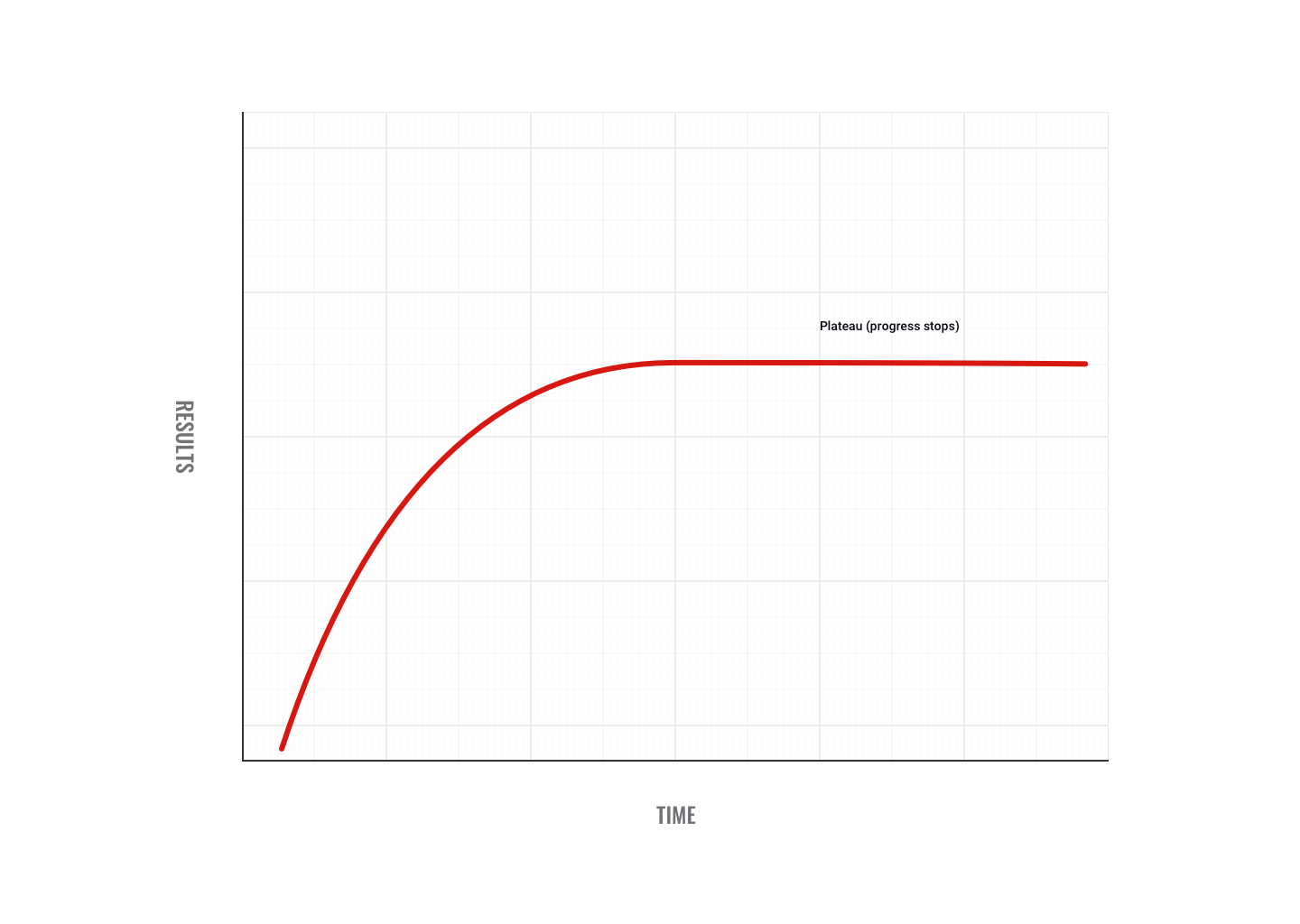
What does the graph show us?
With any training programme and client, gains made early in a training programme come very quickly because they are a long way from their genetic ceiling or potential. However, as they improve, gains become harder and harder to achieve.
Clients need new and innovative training ideas to spark further adaptation. This is one of the main reasons why intermediate-level clients seek the support of a personal trainer!
It is true, variety is the spice of life. It is also the spice of an effective training program!
We have discussed when and why the FITT principles are varied, but it doesn’t stop there. The principle of variety considers a variety of exercise stimuli, which is another factor to consider when achieving optimal adaptation and progression and avoiding overuse and risk of injury. As with other aspects of life, if we as humans do it for too long we become bored, slow down, make mistakes, and can become disengaged.
Our muscles (and neurological system) are much the same, and changing up their stimulus every so often keeps them on their toes (so to speak). A change is as good as a rest they say and a recovery of sorts from day-to-day activity. The same is true for muscles where variety allows for recovery. Resting a muscle or group of muscles, an exercise pattern, or an energy system allows recovery whilst shifting the focus elsewhere for a period of time.
However, this does not mean changing the exercises or exercise stimulus in every session. Each principle, whilst described individually is carefully considered along with the others. This means that a gradual and timely variation of exercise stimuli is more effective (and safe). Look for signs your client is becoming competent in performance and technique and is starting to feel their exercises are 'easy'. Remember, this can be a subjective report, so use your exercise knowledge to judge their readiness for change.
Training contrasting fitness components simultaneously can reduce adaptation (results) in both.
Interference occurs when 2 different forms of training occur simultaneously, and the benefits or adaptations for each clash. If you try to get better at too many things, then something is going to give and you may not experience the same gains in either fitness component compared to if you were to work on only 1 or 2 things at a time.
However, for overall health and fitness, we can focus on multiple goals at a time without too much interference.
Here are 2 scenarios:
- Your client Joe is a semi-professional athlete who wants to combine strength training with endurance training. Both training methods have different training adaptations which will interfere with each other and affect the level of performance he achieves in strength and endurance. The key is ensuring there are sufficient days between strength and endurance training. Ask Joe which of the two would be his preferred focus and decide together the focus of the programme. You may find one preference is a wish, not a need, and in fact, for his next season, one may be a greater focus than the other.
- Caterina is keen to train in hypertrophy and cardiovascular endurance at the same time. We know that to gain mass you need a surplus of calories to grow muscles, while on the other hand, cardiovascular training consumes large amounts of calories which would otherwise go to building muscles. There is a clear and obvious interference at play here. Explain this to Caterina and work together to achieve an optimal and effective programme design.
As a fitness professional, you are equipped with the knowledge and the skills to be amazing. Wow clients with your knowledge of the science behind exercise and share this with them. Explain training principles in a way your client understands. In doing this you will achieve confidence and trust, and your client will be taken on their training journey too as opposed to being left behind in the jungle of science.
